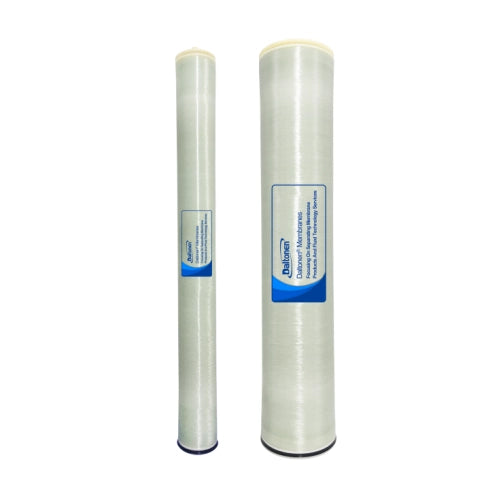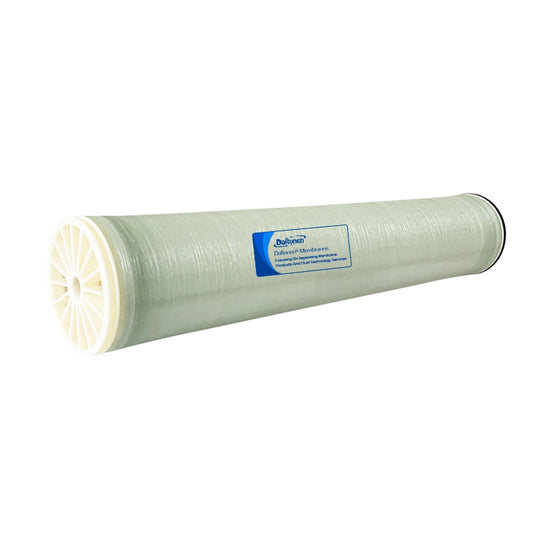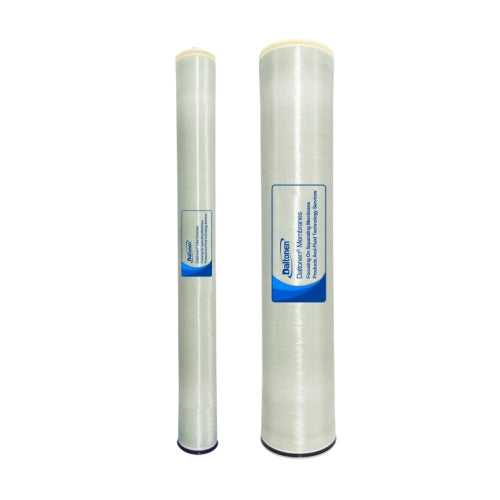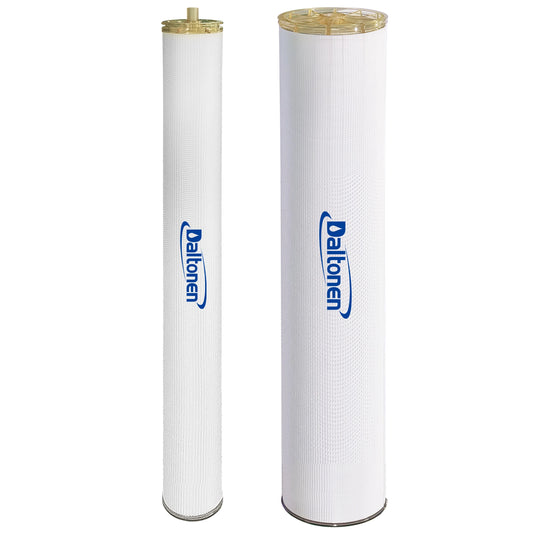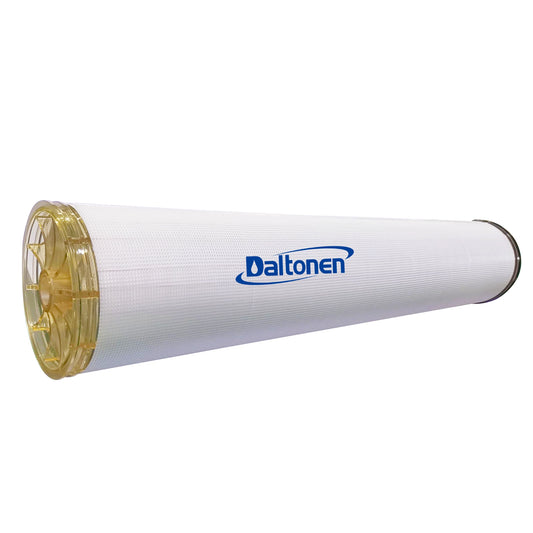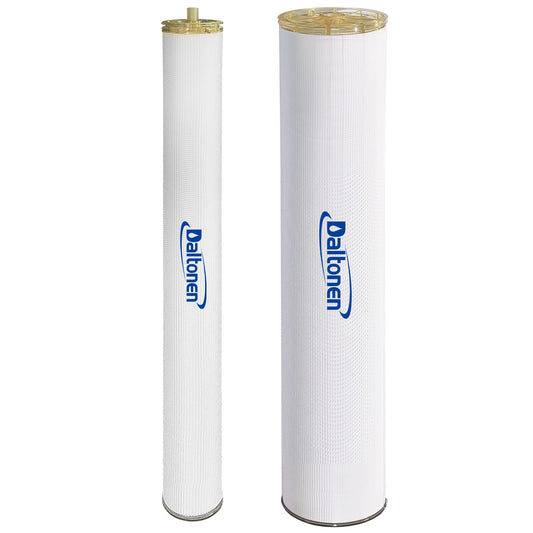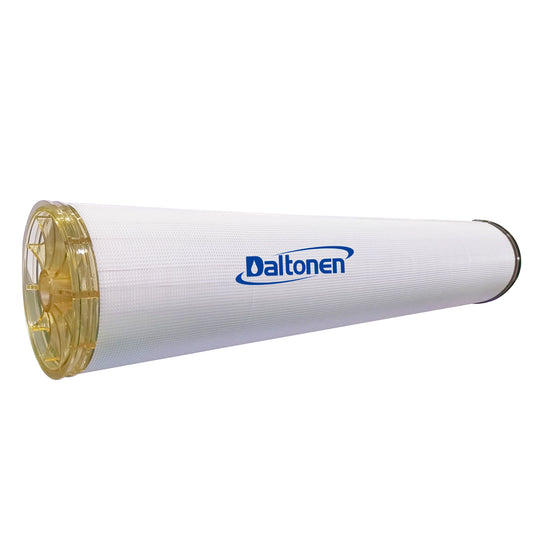Types of Ultrafiltration Membranes Suitable for Large Water Treatment Plants
04 Jun 2025
1. Overview of Ultrafiltration Membrane Types
1.1 Definition and Basic Principles of Ultrafiltration Membranes
Ultrafiltration membranes are thin films with selective permeability, typically with pore sizes ranging from 0.01 to 0.1 micrometers. They can effectively retain large molecules, colloidal particles, bacteria, and viruses in a solution while allowing water and small molecule solutes to pass through, thereby purifying and separating the water. The working principle of ultrafiltration membranes is mainly based on sieving. When water flows through the membrane surface, solvents and small molecule solutes smaller than the membrane pores pass through the membrane under the drive of a pressure difference, while substances larger than the membrane pores are retained on the feed side of the membrane, forming a concentrate. This physical sieving mechanism gives ultrafiltration membranes a broad application prospect in the water treatment field, especially in removing suspended solids, microorganisms, and some dissolved organic matter from water.
1.2 Classification of Ultrafiltration Membranes
Ultrafiltration membranes can be classified according to different criteria, including material classification, structural form classification, and pore size distribution classification.
Material Classification: The material of ultrafiltration membranes is an important factor affecting their performance and applicability. Common materials for ultrafiltration membranes include polyvinylidene fluoride (PVDF), polyethersulfone (PES), polysulfone (PS), polyacrylonitrile (PAN), and cellulose acetate (CA). PVDF membranes have good chemical stability and high-temperature resistance, making them suitable for treating oily wastewater and high-concentration organic wastewater. PES membranes have good hydrophilicity and strong resistance to fouling, and are widely used in municipal water supply and surface water treatment. PS membranes are relatively inexpensive but have weaker resistance to fouling, making them suitable for treating water sources with better quality. PAN membranes have high mechanical strength and good chemical corrosion resistance, making them suitable for seawater desalination pretreatment. CA membranes are inexpensive but have poor resistance to fouling and durability, and are mostly used in disposable, simple water treatment devices.
Structural Form Classification: The structural forms of ultrafiltration membranes mainly include flat sheet membranes, tubular membranes, and hollow fiber membranes. Flat sheet membranes have a large effective filtration area and are easy to clean, but have a low packing density and occupy a large area. Tubular membranes have a larger inner diameter and are less likely to be blocked, making them suitable for treating wastewater containing a large number of solid particles, but their mass transfer efficiency is relatively low. Hollow fiber membranes have the advantages of high packing density, high flux, and low cost, and are currently the most widely used form of ultrafiltration membranes, especially in large-scale water treatment systems, where they have significant economic advantages.
Pore Size Distribution Classification: According to the size and distribution of pores, ultrafiltration membranes can be divided into symmetric pore structure and asymmetric pore structure. Symmetric pore structure ultrafiltration membranes have uniform pore sizes and higher filtration precision, but relatively lower flux. Asymmetric pore structure ultrafiltration membranes have smaller surface pore sizes and gradually larger internal pores. This structure ensures high filtration precision while also having a larger flux, which can effectively improve water treatment efficiency. Therefore, asymmetric pore structure ultrafiltration membranes are more commonly used in practical applications.

2. Ultrafiltration Membrane Types Suitable for a Treatment Capacity of 25,000 Tons
2.1 Submerged Ultrafiltration Membranes
Characteristics: Submerged ultrafiltration membranes are directly immersed in the water to be treated and use negative pressure suction through a pump or siphon. This membrane system has a small footprint and low energy consumption, generally less than 0.1 kW, and is adaptable to a wide range of influent water qualities, effectively handling water with high levels of suspended solids and organic matter.
Applicable Scenarios: Particularly suitable for retrofitting and expanding existing water treatment plants, as they can be directly installed into existing clarifiers, bioreactors, or other water tanks.
Case Example: The Zhejiang T Water Treatment Plant, which sources its water from a local reservoir with excellent water quality and has a water supply scale of 500,000 m³/d, uses submerged ultrafiltration membrane pools with a single pool treatment capacity of 25,000 m³/d.
2.2 Pressurized Ultrafiltration Membranes
Characteristics: The pressurized ultrafiltration membrane system consists of several ultrafiltration membrane modules integrated into a membrane rack to form a membrane stack, with water flow driven through the membrane by a pressure difference. This system produces high-quality effluent, effectively removing particulate matter, colloids, large molecular organic substances, and controlling bacteria and other microorganisms in the water.
Applicable Scenarios: Suitable for water treatment plants with high effluent water quality requirements. For example, the Beijing G Water Treatment Plant uses a cylindrical ultrafiltration membrane system with a treatment scale of 500,000 m³/d, maintaining good water quality even under low-temperature and low-turbidity conditions.
Case Example: The Beijing G Water Treatment Plant's ultrafiltration membrane system is pressurized, with 20 pressurized ultrafiltration membrane stacks per series, each with a treatment capacity of 12,500 m³/d.
2.3 PVDF Hollow Fiber Ultrafiltration Membranes
Characteristics: PVDF (polyvinylidene fluoride) hollow fiber ultrafiltration membranes have good chemical stability and mechanical strength, excellent resistance to fouling, long service life, and uniform pore sizes, effectively retaining suspended solids, bacteria, viruses, and other substances in the water.
Applicable Scenarios: Suitable for water treatment plants with various water quality conditions, especially where high water quality stability and membrane durability are required.
Case Example: GE's ZeeWeed® ultrafiltration membrane, a PVDF hollow fiber membrane, is widely used in large water treatment plants, such as the Dongying South Suburb Water Treatment Plant, which increased its treatment capacity from 100,000 tons/day to 200,000 tons/day.
Considerations
Water Quality Conditions: Different water qualities require ultrafiltration membranes with different pore sizes and materials. If the raw water has high levels of suspended solids and organic matter, membranes with strong resistance to fouling should be chosen.
Treatment Capacity Requirements: Select appropriate membrane modules and system scales based on the actual treatment capacity of the water treatment plant. For a plant with a treatment capacity of 25,000 tons, the required membrane area and number of membrane modules need to be calculated.
Cost and Maintenance: Consider the initial investment, operating costs, and maintenance expenses of the ultrafiltration membrane system. For example, submerged ultrafiltration membrane systems typically have lower energy consumption and maintenance costs.
Space Limitations: If the water treatment plant has limited space, the compact design of submerged ultrafiltration membrane systems may be a better choice.
3. Performance Requirements of Ultrafiltration Membranes
3.1 Filtration Precision
For a water treatment system with a capacity of 25,000 tons, filtration precision is one of the key performance indicators of ultrafiltration membranes. The filtration precision of ultrafiltration membranes mainly depends on their pore size and distribution. According to experimental data, ultrafiltration membranes with pore sizes between 0.01 and 0.1 micrometers can effectively retain suspended solids, bacteria, viruses, and some dissolved organic substances in the water. For example, polyethersulfone (PES) ultrafiltration membranes have uniform pore size distribution and can achieve a filtration precision of up to 99.99%, effectively removing microorganisms and colloidal particles from the water. In large-scale water treatment, high-precision ultrafiltration membranes can ensure that the effluent water quality meets strict water quality standards and satisfies the needs of different application scenarios, such as drinking water treatment and pretreatment of industrial water.
3.2 Flux Stability
Flux stability is an important indicator for measuring the performance of ultrafiltration membranes, especially in large-scale systems handling 25,000 tons of water. Flux stability directly affects treatment efficiency and operating costs. Hollow fiber ultrafiltration membranes, due to their asymmetric pore structure with smaller surface pores and gradually larger internal pores, ensure high filtration precision while also having a larger flux. Experiments have shown that the flux decay rate of hollow fiber ultrafiltration membranes is low, only 10% to 15%, compared to the 20% to 30% of flat sheet ultrafiltration membranes. Additionally, ceramic ultrafiltration membranes, with their special material properties, have extremely high flux stability. Even when treating wastewater containing a large number of solid particles, their flux remains stable. This is particularly important for systems with a capacity of 25,000 tons, as it can effectively reduce the cleaning frequency and maintenance costs associated with flux decline.
3.3 Chemical Resistance
Chemical resistance is a performance that ultrafiltration membranes must have in the water treatment process, especially when treating water sources containing chemical substances. Polyvinylidene fluoride (PVDF) ultrafiltration membranes have excellent chemical resistance and can withstand the erosion of various chemical reagents. Experimental data shows that the performance degradation rate of PVDF ultrafiltration membranes in contact with strong acids, strong bases, and organic solvents is only 5%, far lower than that of other types of ultrafiltration membranes. This chemical resistance makes PVDF ultrafiltration membranes perform well in scenarios such as industrial wastewater treatment and seawater desalination pretreatment. In a system with a capacity of 25,000 tons, chemical resistance not only extends the service life of the membrane but also reduces membrane damage caused by chemical cleaning, thereby lowering maintenance costs and replacement frequency, ensuring the long-term stable operation of the system.

4. System Design of Ultrafiltration Membranes
4.1 System Configuration and Component Selection
The configuration and component selection of ultrafiltration membrane systems are crucial for water treatment with a capacity of 25,000 tons, requiring a comprehensive consideration of treatment efficiency, cost, and stability.
Membrane Module Selection: Based on the treatment capacity and water quality requirements, hollow fiber ultrafiltration membrane modules are an ideal choice. Their high packing density and large flux characteristics can effectively meet the demands of large-scale treatment. For example, for a treatment capacity of 25,000 tons, hollow fiber membrane modules can achieve efficient filtration within a smaller footprint. Additionally, their resistance to fouling can reduce cleaning frequency and lower maintenance costs.
System Configuration: Ultrafiltration membrane systems are typically configured in series or parallel. For a capacity of 25,000 tons, a parallel configuration is recommended to enhance the flexibility and reliability of the system. In a parallel configuration, each ultrafiltration membrane module can operate and be maintained independently, ensuring that the failure of one module does not affect the entire system's operation.
Ancillary Equipment Selection: In addition to the ultrafiltration membrane modules, the system also requires corresponding ancillary equipment, such as booster pumps, backwashing pumps, cleaning devices, and control systems. Booster pumps provide sufficient pressure to drive water through the ultrafiltration membrane, while backwashing pumps are used to regularly clean the membrane surface, removing attached pollutants. Cleaning devices can choose between chemical and physical cleaning methods based on the membrane's fouling conditions. The control system monitors the system's operating status, including pressure, flow, and water quality parameters, to ensure stable operation.
4.2 Pretreatment and Post-treatment Processes
Pretreatment and post-treatment processes play a key role in ultrafiltration membrane systems, effectively improving system operating efficiency and effluent water quality.
Pretreatment Processes: The main purpose of pretreatment is to remove large particulate impurities and some organic matter from the water, reducing the fouling load on the ultrafiltration membrane. Common pretreatment processes include screens, sand filtration, and activated carbon adsorption. Screens can remove large floating objects and suspended solids from the water, while sand filtration can further remove fine particulate impurities. Activated carbon adsorption can remove organic matter and odors from the water, reducing the risk of membrane fouling. For a system with a capacity of 25,000 tons, the selection of pretreatment processes should be optimized based on the characteristics of the water source to ensure the efficient operation of the ultrafiltration membrane.
Post-treatment Processes: Post-treatment processes are mainly used to further improve effluent water quality to meet specific application requirements. Common post-treatment processes include disinfection, ion exchange, and reverse osmosis. Disinfection can kill residual microorganisms in the water, ensuring the biological safety of the effluent. Ion exchange can remove hardness ions and some dissolved impurities from the water, improving the stability of the effluent water quality. Reverse osmosis can further remove dissolved salts and small molecular organic substances from the water, suitable for applications with extremely high water quality requirements, such as electronic industry water and pharmaceutical water. For a system with a capacity of 25,000 tons, the selection of post-treatment processes should be customized based on the user's requirements for effluent water quality.
4.3 Control and Maintenance Systems
Control and maintenance systems are crucial for the long-term stable operation of ultrafiltration membrane systems, requiring the establishment of comprehensive monitoring and maintenance mechanisms.
Control Systems: The control system of ultrafiltration membrane systems should have real-time monitoring and automatic control functions. By installing pressure sensors, flow meters, and water quality monitors, the system's operating status, such as inlet pressure, effluent flow, and water quality parameters, can be monitored in real-time. The control system can automatically adjust operating parameters, such as the speed of booster pumps and the frequency of backwashing, based on monitoring data to ensure stable system operation. Additionally, the control system should have fault alarm functions to promptly issue alerts and take corresponding measures when the system encounters abnormal conditions.
Maintenance Strategies: The maintenance strategy for ultrafiltration membrane systems should include regular cleaning, performance testing, and membrane module replacement. Regular cleaning is a key measure to maintain the flux stability of ultrafiltration membranes, and cleaning methods can be chosen based on the membrane's fouling conditions, such as backwashing, chemical cleaning, or physical cleaning. Performance testing is used to evaluate the filtration efficiency and flux stability of ultrafiltration membranes, promptly identifying any performance degradation. When the performance of membrane modules no longer meets treatment requirements, they should be replaced in a timely manner to ensure the system's normal operation. For a system with a capacity of 25,000 tons, it is recommended to establish detailed maintenance records to document the time, method, and effectiveness of each cleaning and maintenance session, facilitating the analysis and evaluation of the system's operating conditions.
5. Application Case Analysis of Ultrafiltration Membranes
5.1 Municipal Water Supply Treatment
The application of ultrafiltration membranes in municipal water supply treatment is widespread, especially in large-scale water treatment systems. For example, a municipal water treatment plant with a daily treatment capacity of 25,000 tons uses a polyethersulfone (PES) hollow fiber ultrafiltration membrane system and has achieved remarkable results.
Water Quality Improvement: The PES ultrafiltration membrane has a pore size of 0.03 micrometers, which can effectively remove suspended solids, bacteria, and viruses from the water. The effluent turbidity remains stable below 0.1 NTU, with removal rates of fecal coliforms and bacteria both exceeding 99.99%. This ensures that the water quality meets the national drinking water hygiene standards, providing residents with safe and reliable drinking water.
Operating Costs: The system uses hollow fiber membrane modules with high packing density and small footprint. During operation, the system has a stable flux, with an average flux of 25 L/(m²·h) and low energy consumption. The treatment cost per ton of water is only 0.1 yuan. Additionally, the PES membrane has good resistance to fouling, resulting in longer cleaning cycles and further reducing maintenance costs.
System Stability: The ultrafiltration membrane system is configured in parallel, with each membrane module operating independently. Even if individual modules fail, it will not affect the overall water supply. The system is equipped with a complete control system that monitors pressure, flow, and water quality parameters in real-time to ensure stable operation. Over the past three years, the system has operated stably with no major failures and less than one hour of water supply interruption per year.
5.2 Industrial Water Treatment
In the industrial sector, ultrafiltration membranes are widely used in various industrial water treatment systems, especially in treating wastewater containing a large amount of suspended solids and organic matter. For example, an industrial water treatment system with a daily treatment capacity of 25,000 tons at a chemical plant uses a polyvinylidene fluoride (PVDF) flat sheet ultrafiltration membrane system.
Water Quality Purification: The PVDF flat sheet ultrafiltration membrane has a pore size of 0.05 micrometers, which can effectively remove suspended solids, colloidal particles, and some organic substances from the water. The effluent water quality is stable, with a suspended solids content below 1 mg/L and a chemical oxygen demand (COD) removal rate of 60%. This provides good water quality conditions for subsequent advanced treatment processes such as reverse osmosis, ensuring the recycling of industrial water.
Chemical Resistance: PVDF membranes have excellent chemical resistance and can withstand the erosion of strong acids, strong bases, and organic solvents. When treating industrial wastewater containing a variety of chemical substances, the performance degradation rate of PVDF membranes is only 3%, much lower than that of other types of ultrafiltration membranes. This extends the membrane's service life to over three years, reducing replacement frequency and maintenance costs.
Operating Efficiency: The system is configured in series with multiple stages, resulting in high treatment efficiency. During operation, the flux is stable at 20 L/(m²·h), with a cleaning cycle of 15 days. By optimizing the cleaning process, the membrane's flux recovery rate exceeds 90%, ensuring the long-term stable operation of the system. Over the past two years, the system has operated stably without any shutdowns caused by membrane fouling.
5.3 Seawater Desalination Pretreatment
Seawater desalination is one of the important ways to solve the problem of water scarcity, and ultrafiltration membranes play a key role in seawater desalination pretreatment. For example, a seawater desalination pretreatment system with a daily treatment capacity of 25,000 tons on an island uses ceramic ultrafiltration membranes.
Efficient Pretreatment: The ceramic ultrafiltration membrane has a pore size of 0.02 micrometers, which can effectively remove suspended solids, microorganisms, and some dissolved organic substances from seawater. The effluent water quality is stable, with turbidity below 0.2 NTU and a bacterial total removal rate of 99.9%. This provides high-quality feed water for the subsequent reverse osmosis seawater desalination process, improving the efficiency and stability of seawater desalination.
High-Temperature and Chemical Stability: Ceramic ultrafiltration membranes have excellent high-temperature resistance and chemical stability, and can operate stably in high-temperature and strong acid-base environments. In seawater desalination pretreatment, ceramic membranes can withstand the high salinity and corrosiveness of seawater, with a service life of over five years. This significantly reduces the cost of membrane replacement and maintenance frequency.
System Reliability: The system is configured in parallel, with each membrane module operating independently, ensuring the high reliability and flexibility of the system. The system is equipped with an advanced control system that monitors water quality, pressure, and flow parameters in real-time, automatically adjusts operating parameters, and ensures stable operation. Over the past four years, the system has operated stably without any shutdowns caused by membrane fouling or damage.
6. Economic Assessment of Ultrafiltration Membranes
6.1 Initial Investment Costs
The initial investment costs of ultrafiltration membrane systems mainly include membrane modules, ancillary equipment, installation costs, and pre-treatment and post-treatment process equipment. For a water treatment system with a capacity of 25,000 tons, there are significant differences in initial investment costs among different types of ultrafiltration membranes.
Hollow Fiber Ultrafiltration Membranes: Due to their high packing density, large flux, and mature manufacturing processes, the cost per unit of treatment capacity is relatively low. For example, polyvinylidene fluoride (PVDF) hollow fiber ultrafiltration membranes have an initial investment cost of approximately $225,000. These membrane modules have a lower purchase cost and can effectively reduce equipment footprint in large-scale systems, thereby reducing civil construction and installation costs.
Flat Sheet Ultrafiltration Membranes: They have a simple structure and are easy to clean, but have a lower packing density and larger footprint. Therefore, their initial investment cost is relatively higher, at around $270,000. Despite this, flat sheet ultrafiltration membranes have strong customizability and can optimize membrane area and pore size according to specific needs, giving them an advantage in certain specific application scenarios.
Ceramic Ultrafiltration Membranes: They have excellent high-temperature resistance and chemical stability, and a long service life, but their manufacturing process is complex and costly. For a system with a capacity of 25,000 tons, the initial investment cost of ceramic ultrafiltration membranes is approximately $330,000. Although the initial investment is high, their long life and low energy consumption characteristics can save costs in long-term operation.
6.2 Operating and Maintenance Costs
The operating and maintenance costs of ultrafiltration membrane systems mainly include energy consumption, cleaning frequency, membrane module replacement, and chemical reagent consumption.
Energy Consumption: Hollow fiber ultrafiltration membranes have a larger flux and lower energy consumption. For example, the operating energy consumption of polyethersulfone (PES) hollow fiber ultrafiltration membranes is approximately 0.05 kWh/m³. Flat sheet ultrafiltration membranes have poorer flux stability and slightly higher energy consumption, at around 0.07 kWh/m³. Ceramic ultrafiltration membranes have a higher flux, but due to their material characteristics, their energy consumption is also relatively higher, at about 0.08 kWh/m³.
Cleaning Frequency: Hollow fiber ultrafiltration membranes have better resistance to fouling and longer cleaning cycles, generally around 30 days. Flat sheet ultrafiltration membranes have shorter cleaning cycles, at about 15 days. Ceramic ultrafiltration membranes, due to their special material characteristics, have the longest cleaning cycle, up to 60 days. The cleaning frequency directly affects the consumption of chemical reagents and labor costs.
Membrane Module Replacement: The service life of hollow fiber ultrafiltration membranes is generally 3 to 5 years, that of flat sheet ultrafiltration membranes is 2 to 3 years, and that of ceramic ultrafiltration membranes can reach over 5 years. The cost of replacing membrane modules is relatively high, so ceramic ultrafiltration membranes with a longer life have a greater economic advantage in long-term operation.
Chemical Reagent Consumption: Chemical reagents such as acids, bases, and oxidants are used in the cleaning process. Hollow fiber ultrafiltration membranes have lower chemical reagent consumption, at about 0.02 kg/m³. Flat sheet ultrafiltration membranes have higher chemical reagent consumption, at around 0.04 kg/m³. Ceramic ultrafiltration membranes have moderate chemical reagent consumption, at about 0.03 kg/m³.
6.3 Total Cost of Ownership
The total cost of ownership (TCO) is an important indicator for evaluating the economic viability of ultrafiltration membrane systems, covering initial investment costs, operating and maintenance costs, and system service life, among other aspects.
Hollow Fiber Ultrafiltration Membranes: They have lower initial investment costs, moderate operating and maintenance costs, and longer service life. Considering all factors, their total cost of ownership for a system with a capacity of 25,000 tons is approximately $330,000.
Flat Sheet Ultrafiltration Membranes: Although they have higher initial investment costs, their strong customizability and high filtration precision give them an advantage in certain specific application scenarios. Their total cost of ownership is around $360,000.
Ceramic Ultrafiltration Membranes: Despite their higher initial investment and operating and maintenance costs, their long life and low energy consumption characteristics make them more economically advantageous in long-term operation. Their total cost of ownership is approximately $375,000.
7. Market and Development Trends of Ultrafiltration Membranes
7.1 Market Competition Landscape
The ultrafiltration membrane market is characterized by diversified competition, with major players including internationally renowned brands and emerging domestic companies.
International Brands Dominate the High-End Market: Dow Chemical, as a global leading manufacturer of ultrafiltration membranes, holds an important position in the fields of municipal water supply and industrial water treatment. For example, Dow's SFP2880 ultrafiltration membrane modules, with their high packing density and large flux characteristics, are widely used in large water treatment systems with a daily treatment capacity exceeding 50,000 tons. In addition, international giants such as GE Water and Siemens also occupy a significant share of the high-end market with their advanced technology and brand advantages.
Domestic Companies Rising: In recent years, domestic ultrafiltration membrane companies have made significant progress in technology research and market expansion. For example, Tianjin Membrane Technology Co., Ltd., produces hollow fiber ultrafiltration membranes that perform well in municipal water supply and industrial wastewater treatment, with product performance comparable to international brands but at a more competitive price. In addition, domestic companies such as Beijing Times Water Technology Co., Ltd., are also expanding their market share and promoting the development of the domestic ultrafiltration membrane industry.
Market Share Distribution: According to market research data, in 2024, international brands accounted for about 60% of the global ultrafiltration membrane market share, while domestic companies accounted for the remaining 40%. In water treatment projects with a capacity of 25,000 tons, products from both international brands and domestic companies are widely used. However, international brands still have an advantage in high-end fields such as municipal water supply and seawater desalination, while domestic companies are more competitive in industrial wastewater treatment and small and medium-sized water treatment projects.
7.2 Technological Development Trends
The development of ultrafiltration membrane technology is showing trends in multiple aspects, aiming to improve performance, reduce costs, and expand application areas.
High-Performance Membrane Material Research and Development: In the future, the research and development of ultrafiltration membranes will focus more on high-performance membrane materials. For example, new types of nanocomposite membrane materials are under research. These materials, which incorporate nanoparticles into traditional membrane materials, can significantly enhance the membrane's resistance to fouling and flux stability. In addition, membrane materials with self-cleaning functions are also being developed. These membranes can automatically remove pollutants from their surface, reducing cleaning frequency and extending membrane life.
Intelligent Membrane Systems: With the development of the Internet of Things and big data technologies, intelligent ultrafiltration membrane systems will become a future development direction. By installing sensors and intelligent control systems in ultrafiltration membrane systems, it is possible to monitor the membrane's operating status in real-time, including flux, pressure, water quality, and other parameters, and automatically adjust operating parameters based on monitoring data to achieve intelligent system operation. This intelligent system not only improves system operating efficiency but also reduces maintenance costs and human intervention.
Integration and Multi-functionality: Ultrafiltration membrane technology will be integrated with other water treatment technologies to form multi-functional water treatment systems. For example, combining ultrafiltration membranes with reverse osmosis, activated carbon adsorption, and other technologies can further improve water purification effectiveness and meet the strict requirements of different application scenarios. In addition, the design of integrated systems will focus more on modularity and flexibility, making it easier to adjust and expand according to treatment capacity and water quality requirements.
7.3 Future Application Prospects
Ultrafiltration membranes have a broad application prospect in the future water treatment field, especially in addressing the issues of water scarcity and water pollution.
Municipal Water Supply Sector: With the acceleration of urbanization and the increasing demands for drinking water quality, the application of ultrafiltration membranes in municipal water supply will continue to expand. It is projected that by 2030, over 50% of municipal water supply systems worldwide will adopt ultrafiltration membrane technology. In municipal water supply projects with a capacity of 25,000 tons, ultrafiltration membranes can effectively remove suspended solids, bacteria, and viruses from water, ensuring that the water quality meets stringent hygiene standards and providing residents with safe and reliable drinking water.
Industrial Water Treatment: In the industrial sector, ultrafiltration membranes will be widely used in various industrial water treatment systems, especially in treating wastewater containing a large amount of suspended solids and organic matter. For example, in industries such as chemicals, pharmaceuticals, and electronics, ultrafiltration membranes can effectively remove pollutants from wastewater, improve water quality, and enable the recycling of water resources. In addition, the application of ultrafiltration membranes in seawater desalination pretreatment will also increase, providing support for solving water scarcity problems.
Emerging Application Areas: In addition to traditional water treatment fields, ultrafiltration membranes will also expand into emerging application areas in the future, such as the food and beverage industry, biopharmaceutical industry, and new energy sector. In the food and beverage industry, ultrafiltration membranes can be used to remove microorganisms and impurities from water, ensuring product quality and safety. In the biopharmaceutical industry, ultrafiltration membranes can be used to separate and purify bioactive substances, improving production efficiency and product quality. In the new energy sector, ultrafiltration membranes can be used to treat wastewater from lithium-ion battery production, recovering valuable metal resources.
Tags:
